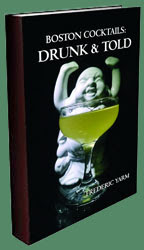One of the other talks I went to at Thirst Boston on Sunday was Pirates, Partisans, & Grandmothers: The Legacy and Use of Sherry given by Jackson Cannon and Derek Brown. Jackson Cannon is well known here in Boston as the leader of the Kenmore bar trilogy -- Eastern Standard, Island Creek Oyster Bar, and Hawthorne -- as well as recently the second runner up in the 2012 Vinos de Jerez sherry cocktail competition. Washington D.C.'s Derek Brown opened up the Passenger and Columbia Room in 2009 and 6 months ago launched Mockingbird Hill that features 90 sherries. Derek explained that the focus for the talk was "How to unfuck sherry?", for many people believe that only old people drink sherry. He thought that it would be cool if they actually did, but it is not the case anymore.
Sherry's history goes back to ancient times with 3000 years of history. The Phoenicians took vines throughout the ancient world, and the wines that came about were quite different but had some similarities especially with the modern sweeter styles of sherry. The Moors advanced sherry making by taking the new advancements of science, namely distillation, from North Africa into Spain. The fortification of wine proved to be advantageous especially during the Age of Exploration for regular wines would go bad on a ship's voyage while wines with additional proof would be stable for longer. Although Columbus took sherry on his voyages to the New World, it was Magellan who set the record by spending more money on sherry than on food and workers. Later, sherry solidified its place in Spanish viticulture by becoming the country's first Denominación de Origen.
Three main grape types predominate sherry production. The Palamino grape grows well on chalky soils similar to those found in Champagne and Cognac in France. The Palamino is technically three different and accounts for 97% of all plantings in Jerez. The other two are Pedro Ximénez and Muscatel which grow better on clay-based soils. PX is often raisinated, except for the dry sherry versions, from sun maturation before fermentation. Meanwhile, the Muscatel is not as sun-concentrated and displays earthy fruit notes; this grape produces wines closer to the ancient Phoenician style.
Derek broke down sherry into 3 'F' words. First, fortify. Sherry starts out as a still table wine that is fortified to around 15% ABV. Second, flor. The flor is a thick, white cap of yeast that protects the wine from being oxidized. Finally, fractionalized blending. Sherry often utilizes a solera system where a third of each barrel is taken away and replaced with newer wines. Statistically, some old sherry is still present in the solera.
There are four major styles of dry sherries. The Fino made from Palamino grapes maintains that protective layer of flor and keeps a non-oxidized flavor. The Manzanilla is more localized for it is a Fino produced in Sanlúcar. When the flor is not allowed to develop such as by killing it in the fortification step or by getting rid of it, it will oxidize and become an Oloroso. The Amontillado is another oxidized sherry that has the nose of an Oloroso and the finish of a Fino. A fifth dry sherry is the Palo Cortado that tastes like an Amontillado and an Oloroso, but it is a designation assigned by a committee as judged for the wine's flavor characteristics.
As for sweet sherries, the two major ones are Pedro Ximénez and Muscatel with both using sun-drenched raisinated processes and different fortification methods than the dry sherries. Cream is a mix of Oloroso and Pedro Ximénez sherries with Lustau's East India Solera being one of the more famous. Pale Cream, on the other hand, is grape syrup mixed with a Fino -- a style that erupted in the 1970s with Harveys Bristol Cream. A Medium designation was recently added, but Derek would love to see that one go away.
The popularity of sherry boomed with the Cobbler that was first mentioned by Washington Irving in 1809. While it is a simple drink, it requires crushed ice and its success rapidly followed Frederic Tudor's first ice shipments starting in 1806. Its success went hand-in-hand with the spread of ice appreciation in drinks. Back then, the Cobbler was mostly made with oxidized sherries that were slightly sweet. Derek mentioned that his favorite use of sherry was in the Adonis which is basically a Sherry Manhattan with sweet vermouth, orange and aromatic bitters.
Since sherry is exceedingly complex with over 300 volatile elements, it often pairs very well with food. Some classic combinations in Spain are Fino and ham, Manzanilla and oysters, and Amontillado and egg. Sherry has also recently worked well the bone and oyster luges phenomenon (pouring the wine over where the bone marrow or mollusk once was).
When asked if they could only have three bottles of sherry, Derek began by listing a Manzanilla from either La Gitana or La Cigarrera, an Amontillado such as Lustau's Los Arcos, and a Cream for sweetness such as Lustau East India Solera. Jackson commented that Lustau's E.I.S. has proven to be an indispensable cocktail ingredient and definitely agreed with Derek's list. He rounded out his list with an Oloroso such as from Alvear and a Palo Cortado such as Hidalgo's 30 Year Wellington.
Wednesday, November 13, 2013
Subscribe to:
Post Comments (Atom)
 The 2017 collection of 855 drink recipes, bartender tributes, and essays on hospitality from CocktailVirgin's Frederic Yarm. Available at
The 2017 collection of 855 drink recipes, bartender tributes, and essays on hospitality from CocktailVirgin's Frederic Yarm. Available at  The 2012 collection of 505 drink recipes, techniques, and Boston bar recommendations from Frederic Yarm. Available at
The 2012 collection of 505 drink recipes, techniques, and Boston bar recommendations from Frederic Yarm. Available at 




No comments:
Post a Comment